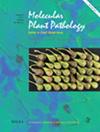ZmmiR398b 通过靶向 ZmCSD2/4/9 负向调节玉米对甘蔗花叶病毒感染的抗性
IF 4.8
1区 农林科学
Q1 PLANT SCIENCES
引用次数: 0
摘要
微RNA(miRNA)广泛参与植物的各种生物学过程,并有助于植物抵抗各种病原体。本研究发现,玉米(Zea mays)抗性近交系 Chang7-2 感染甘蔗花叶病毒(SCMV)后,miR398b(ZmmiR398b)的积累显著减少,而易感近交系 Mo17 的积累则显著增加。降解组测序分析和瞬时共表达实验发现,ZmmiR398b在体内可靶向铜/锌-过氧化物酶歧化酶2(ZmCSD2)、ZmCSD4和ZmCSD9,其中ZmCSD9的表达水平在SCMV感染Chang7-2和Mo17后全部上调。此外,过表达 ZmmiR398b(OE398b)的玉米植株对 SCMV 感染的敏感性增加,可能是由于活性氧(ROS)积累增加所致,这与 ZmCSD2/4/9 沉默的玉米植株一致。相比之下,通过短串联靶标模拟(STM)技术沉默 ZmmiR398b(STM398b)可增强玉米对 SCMV 感染的抗性并降低 ROS 水平。有趣的是,铜(Cu)梯度水培实验表明,铜缺乏会促进 SCMV 感染,而铜充足时则会通过调节玉米中 ZmmiR398b 和 ZmCSD2/4/9 的积累抑制 SCMV 感染。这些结果表明,操纵 ZmmiR398b-ZmCSD2/4/9-ROS 模块为开发耐 SCMV 玉米品种提供了一种前瞻性策略。本文章由计算机程序翻译,如有差异,请以英文原文为准。
ZmmiR398b negatively regulates maize resistance to sugarcane mosaic virus infection by targeting ZmCSD2/4/9
MicroRNAs (miRNAs) are widely involved in various biological processes of plants and contribute to plant resistance against various pathogens. In this study, upon sugarcane mosaic virus (SCMV) infection, the accumulation of maize (Zea mays ) miR398b (ZmmiR398b) was significantly reduced in resistant inbred line Chang7‐2, while it was increased in susceptible inbred line Mo17. Degradome sequencing analysis coupled with transient co‐expression assays revealed that ZmmiR398b can target Cu/Zn‐superoxidase dismutase2 (ZmCSD2 ), ZmCSD4 , and ZmCSD9 in vivo, of which the expression levels were all upregulated by SCMV infection in Chang7‐2 and Mo17. Moreover, overexpressing ZmmiR398b (OE398b) exhibited increased susceptibility to SCMV infection, probably by increasing reactive oxygen species (ROS) accumulation, which were consistent with ZmCSD2/4/9 ‐silenced maize plants. By contrast, silencing ZmmiR398b (STTM398b) through short tandem target mimic (STTM) technology enhanced maize resistance to SCMV infection and decreased ROS levels. Interestingly, copper (Cu)‐gradient hydroponic experiments demonstrated that Cu deficiency promoted SCMV infection while Cu sufficiency inhibited SCMV infection by regulating accumulations of ZmmiR398b and ZmCSD2/4/9 in maize. These results revealed that manipulating the ZmmiR398b‐ZmCSD2/4/9‐ ROS module provides a prospective strategy for developing SCMV‐tolerant maize varieties.
求助全文
通过发布文献求助,成功后即可免费获取论文全文。
去求助
来源期刊

Molecular plant pathology
生物-植物科学
CiteScore
9.40
自引率
4.10%
发文量
120
审稿时长
6-12 weeks
期刊介绍:
Molecular Plant Pathology is now an open access journal. Authors pay an article processing charge to publish in the journal and all articles will be freely available to anyone. BSPP members will be granted a 20% discount on article charges. The Editorial focus and policy of the journal has not be changed and the editorial team will continue to apply the same rigorous standards of peer review and acceptance criteria.
 求助内容:
求助内容: 应助结果提醒方式:
应助结果提醒方式:


